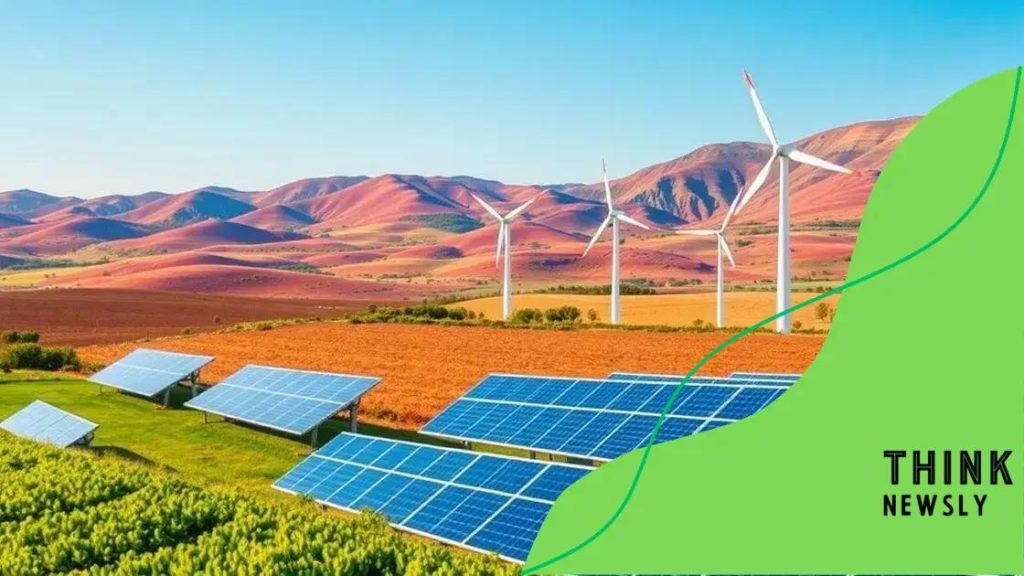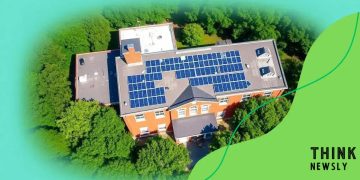Renewable infrastructure strategy for sustainable growth

Anúncios
A renewable infrastructure strategy focuses on integrating sustainable energy sources, technologies, and community engagement to effectively reduce reliance on fossil fuels and promote long-term environmental and economic benefits.
Renewable infrastructure strategy plays a critical role in shaping sustainable communities. By focusing on green solutions, it’s possible to foster economic growth while protecting our planet. Ready to learn more about how this strategy can impact your future?
Anúncios
Understanding renewable infrastructure
Understanding renewable infrastructure is essential for creating sustainable communities. It encompasses various systems, technologies, and strategies that harness renewable energy sources. By investing in these infrastructures, we can reduce our reliance on fossil fuels and lower greenhouse gas emissions.
To truly appreciate renewable infrastructure, we need to explore its key components. Each part plays a role in ensuring that we can transition smoothly from conventional energy systems.
Main Components of Renewable Infrastructure
Some of the critical elements include:
Anúncios
- Solar Energy Systems: Harnessing the sun’s rays using photovoltaic cells or solar thermal systems.
- Wind Energy Turbines: Capturing wind energy through turbines to produce electricity.
- Hydropower Facilities: Utilizing flowing water to generate energy.
- Energy Storage Solutions: Implementing batteries and other technologies to store energy for later use.
Transitioning to renewable infrastructure is about more than just technology; it involves creating an interconnected system. For instance, consider how solar panels can work in tandem with wind turbines to provide a stable energy supply. This harmony not only maximizes energy production but also minimizes environmental impact.
Every community has unique needs, which means renewable infrastructure should be tailored accordingly. Local resources, climate, and community goals play a part in shaping these systems. For instance, coastal regions may rely more on wind and solar, while others might incorporate biomass.
Benefits of Renewable Infrastructure
By investing in renewable infrastructure, we can achieve numerous benefits:
- Decreased carbon footprint and pollution.
- Job creation in emerging green technologies.
- Increased energy independence and stability.
- Long-term cost savings on energy bills.
As we explore the potential of renewable infrastructure, it’s crucial to recognize the support it needs from both local and national policies. Government incentives and community involvement can significantly influence the adoption and success of renewable energy projects.
Ultimately, a comprehensive approach to understanding renewable infrastructure paves the way for sustainable growth. By investing in these systems today, we prepare for a cleaner, greener tomorrow and make strides toward climate resilience while promoting economic prosperity.
Key components of a successful strategy
To develop a strong renewable infrastructure strategy, understanding the key components is vital. These elements work together to create a cohesive framework that promotes sustainability and efficiency.
First, let’s explore the vital components that make up a successful strategy.
Essential Elements of Renewable Infrastructure
Each element brings unique advantages:
- Policy Framework: Establishing regulations and incentives that support renewable projects.
- Technological Innovation: Integrating advanced technologies to improve efficiency and reduce costs.
- Community Engagement: Involving local stakeholders to ensure support and address concerns.
- Financial Investment: Securing funding from diverse sources to implement renewable projects.
A robust renewable infrastructure strategy requires a strong policy framework. Policies guide the direction of renewable projects and define how communities can benefit. They establish rules that encourage investments and promote clean energy initiatives.
Next, technological innovation is at the heart of optimizing renewable energy use. New technologies can significantly elevate the efficiency of systems, like smart grids and improved energy storage solutions. These advancements make renewable energies more reliable and accessible.
Engaging the Community
Community engagement is just as critical. A strategy that listens to local needs ensures broader acceptance and ownership of projects. When communities feel included, they are more likely to support sustainable practices.
Lastly, financial investment plays a key role. Innovative funding models attract both private and public investment, ensuring the necessary capital for development. This investment is essential to kick-start projects and maintain long-term sustainability.
Ultimately, these key components work in harmony to create a successful renewable infrastructure strategy. By understanding and implementing these elements, communities can navigate the complexities of transitioning to sustainable energy sources effectively.
The role of technology in renewable infrastructure

Technology plays a crucial role in shaping renewable infrastructure. It enhances efficiency, reduces costs, and enables better integration of renewable energy sources into existing systems.
From solar panels to wind turbines, innovative technologies are central to generating and harnessing clean energy. These advancements ensure that renewable resources can compete with conventional energy sources.
Advancements in Renewable Energy Technology
Notable developments in technology include:
- Smart Grids: These grids optimize electricity distribution by managing supply and demand in real-time.
- Energy Storage Solutions: Advanced battery technologies store excess energy for use during peak demand.
- Efficiency-Boosting Software: Algorithms analyze energy usage patterns, allowing for more efficient facility operations.
- Microgrid Systems: These localized grids can operate independently, enhancing energy resilience.
As renewable infrastructure grows, the integration of technology becomes increasingly important. Smart grids highlight how data and connectivity are used to enhance performance. They allow utilities to monitor energy flow and identify areas where adjustments are needed to maintain balance.
In addition to smart grids, energy storage solutions are vital to managing the intermittent nature of renewable resources. Photosynthesis-driven solar power generation may not always align with energy consumption. Therefore, effective energy storage systems ensure a continuous power supply, making renewable energy reliable and appealing.
The Future of Technology in Renewables
Looking toward the future, the role of technology in renewable infrastructure will continue to expand. Innovations will drive the sector forward, allowing for more integrated and efficient systems. For instance, the development of artificial intelligence (AI) can predict energy outages, enhancing response strategies. Additionally, the use of IoT (Internet of Things) devices can provide real-time data collection, improving overall infrastructure operation.
In essence, the interplay between technology and renewable infrastructure paves the way for a sustainable future. By continuing to innovate and adopt new solutions, we can significantly reduce our environmental impact while ensuring that communities have access to clean energy.
Case studies on successful implementations
Examining case studies on successful implementations of renewable infrastructure highlights the tangible benefits these projects can bring. By assessing real-world examples, we can understand both strategies that worked and valuable lessons learned.
One notable case study is the adoption of solar energy in a small town. The community faced high energy costs and decided to invest in solar panels. This project not only reduced energy bills but also promoted local employment through installation and maintenance jobs. The town now runs on over 70% renewable energy.
Successful Wind Energy Project
Another example involves a wind farm built in a coastal region. Initially, there were concerns about aesthetics and environmental impact. However, through community workshops and engagement, residents became supportive. The wind farm generated significant revenue and created numerous job opportunities.
Key factors contributing to this project’s success included:
- Community Involvement: Local residents were involved from the early planning stages, allowing them to voice concerns and influence decisions.
- Government Support: Financial incentives and clear policies were implemented to encourage investment in wind energy.
- Partnerships: Collaboration with local businesses and educational institutions facilitated training programs for skilled workers.
These case studies demonstrate how effective planning and community engagement lead to successful outcomes. They also show the importance of adapting strategies based on local needs and resources.
Sustainable Urban Development
A successful case in urban areas involves integrating green roofs and urban gardens in city planning. A city implemented a green infrastructure initiative to improve air quality and decrease heat effects. They provided incentives for building owners to install green roofs, which not only enhanced aesthetics but also provided insulation and reduced stormwater runoff.
Noteworthy benefits included:
- Improved Air Quality: Green spaces helped to filter pollutants, making the city healthier.
- Temperature Regulation: These buildings became energy efficient due to insulation from plant cover.
- Social Engagement: Residents participated in gardening, fostering community ties.
These examples illustrate that implementing renewable infrastructure is not only about technology but also about community, resources, and adaptability. Learning from these successful case studies provides a roadmap for future projects, guiding best practices in integrating renewable energy into our lives.
Future trends in renewable energy infrastructure
Future trends in renewable energy infrastructure are essential for shaping how we power our homes and businesses. As technology evolves, so does the potential for more efficient and sustainable practices.
One prominent trend is the continued rise of decentralized energy systems. These systems allow communities to generate their own energy using local resources. For instance, small solar installations and wind turbines can create energy that reduces reliance on larger power grids.
Growth of Smart Technology
With the advent of smart technology, energy management becomes more efficient. Smart meters and advanced software allow users to monitor and adjust their energy consumption in real-time. This accessibility encourages more responsible energy use and reduces waste.
As we look at renewable energy trends, we see a greater emphasis on energy storage solutions. Innovations in battery technology are paving the way for storing excess energy generated from sources like solar and wind. This capability not only stabilizes the energy supply but also makes renewable energy more attractive to consumers.
Integration of Artificial Intelligence
Artificial Intelligence (AI) is also shaping the future of renewable energy infrastructure. Machine learning algorithms can predict energy demand, optimize energy generation, and even enhance maintenance practices. This technology can minimize downtimes and maintain efficiency.
Additionally, the role of hybrid systems is becoming more prominent. Hybrid systems combine different renewable sources, such as solar and wind, to create a reliable energy supply. This approach increases resilience against fluctuations in availability and enhances overall efficiency.
Lastly, sustainability focuses on eco-friendly building practices. New infrastructure designs are incorporating more green materials and energy-efficient technologies. For example, structures may utilize sustainable materials for solar roof installations or green building certifications that promote reduced environmental impact.
In summary, future trends in renewable energy infrastructure are heading toward more decentralized, smart, and efficient systems. The incorporation of innovative technologies, storage solutions, and sustainable practices will help communities meet their energy needs while reducing their carbon footprint.
FAQ – Frequently Asked Questions about Renewable Infrastructure
What is renewable infrastructure?
Renewable infrastructure refers to systems and technologies that utilize renewable energy sources, such as solar, wind, and hydropower, to produce and manage energy.
How can communities benefit from renewable energy?
Communities can benefit from renewable energy through reduced energy costs, job creation, and improved local economies, as well as enhanced environmental sustainability.
What role does technology play in renewable energy?
Technology optimizes renewable energy generation, enhances energy efficiency, and supports the integration of smart grids and energy storage solutions.
What are some successful examples of renewable energy projects?
Successful examples include community solar initiatives, wind farms that engage local stakeholders, and cities incorporating green roofs and urban gardens.





